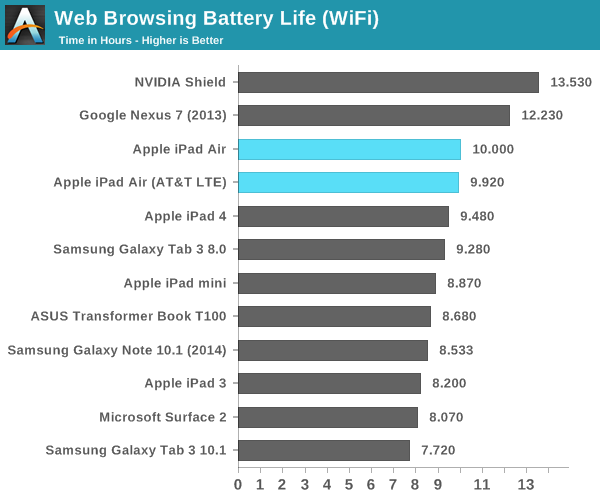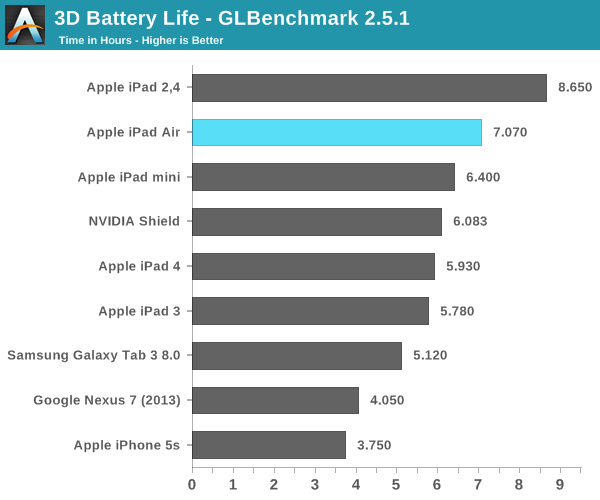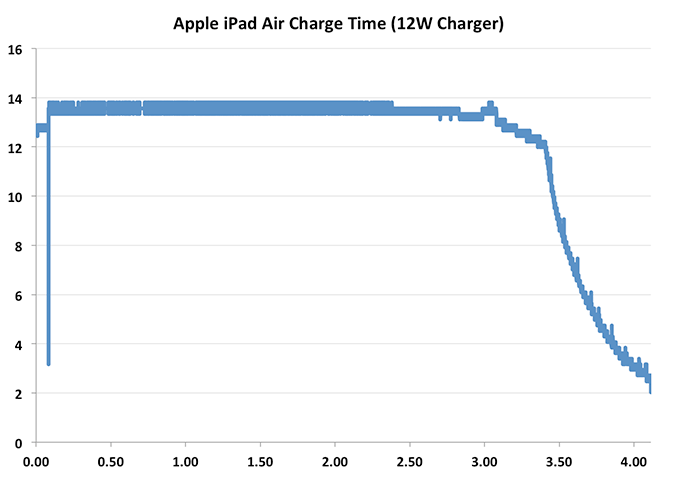The iPad Air Review
by Anand Lal Shimpi on October 29, 2013 9:00 PM ESTBattery Life
With the iPad Air Apple moved to a 32.4Wh battery, a significant decrease from the 42.5Wh unit in the 3rd and 4th generation iPads. The smaller battery doesn’t come with a change to Apple’s claim of 10 hours of battery life, which implies a reduction in overall platform power. I confirmed a substantial reduction in platform power in my crude measurements earlier in the article. Although it’s possible for the iPad Air to draw substantially more power than the iPad 4, our earlier power data seems to imply that it’s unlikely given the same exact workload. Our battery life tests agree.
We'll start with our 2013 smartphone/tablet web browsing battery life test. As always all displays are calibrated to 200 nits. The workload itself is hidden from OEMs to avoid any intentional gaming, but I've described it at a high level here.

Our web browsing workload came in at exactly 10 hours of continuous usage - an improvement compared to the iPad 4. Battery life on LTE was good as well, consistently delivering just under 10 hours of usage. The fact that both LTE and WiFi tests deliver similar results tells me that we may be bottlenecked by some other component in the system (perhaps display?).
I've been running the same video playback test for a while now, although we're quickly approaching a point where I'll need to move to a higher bitrate 1080p test. Here I'm playing a 4Mbps H.264 High Profile 720p rip I made of the Harry Potter 8 Blu-ray. The full movie plays through and is looped until the battery dies. Once again, the displays are calibrated to 200 nits:

Video playback battery life also improves slightly compared to the iPad 4. Apple’s battery life claims aren’t usually based around video playback, so exceeding their 10 hour suggestion here shouldn’t come as a shock. Apple’s video decode power has always been extremely low.
Our final cross-platform battery life test is based on Kishonti's Egypt HD test. Here we have a loop of the Egypt HD benchmark, capped to 30 fps, running on all of the devices with their screens calibrated to 200 nits.

Our 3D battery life rundown test shows a substantial improvement in battery life over the iPad 4. IMG’s PowerVR G6430, running a moderate workload, can do so more efficiently than any of the previous generation GPUs in Apple’s SoCs. Much like the A7’s CPU cores however, there’s a wider dynamic range of power consumption with the G6430. Running at max performance I would expect to see greater GPU power consumption. The question then becomes what’s more likely? Since the majority of iOS games don’t target the A7 (and instead shoot for lower end hardware), I would expect you to see better battery life even while gaming on the iPad Air vs the iPad 3/4.
Charge Time
The iPad Air comes with the same 12W USB charger and Lightning cable that we first saw with the iPad 4. Having to only charge a 32.5W battery means that charge times are lower compared to the iPad 3 and 4:

A full charge takes a little over 4 hours to complete. The adapter delivers as much as 12W to the iPad, drawing a maximum of 13.5W at the wall. I still think the sweet spot is somewhere closer to 2.5 hours but that’s another balancing game that must be played between charge time and maintaining battery health. It’s still so much better than the ~6 hours of charge time for the iPad 3 and 5.69 hours for the iPad 4.











444 Comments
View All Comments
blacks329 - Tuesday, October 29, 2013 - link
The pointless dilemma caused by AnandTech reviews: Do I read it now and spoil all my other reviews, or do I save it for later after reading all the other 'reviews' but feel underwhelmed by reading them.I feel like a child wanting to have dessert, except this dessert is actually better for me than the main course, but I'm gonna have the main course anyway because of my OCD with tech reviews.
(I like reading multiple reviews for a product - even if I have no intent to purchase them)
ArthurG - Tuesday, October 29, 2013 - link
a bit OT, but more I look at the graphs, more I think SHIELD is a great piece of hardware ! Screen, GPU performance and battery life are top class. And with the last 4.3 update, its coming all together on the software side.I'm holding the trigger because I think SHIELD 2 will be the real deal with amazing Logan GPU. But the first iteration is already very tempting...
Commodus - Tuesday, October 29, 2013 - link
Definitely. There's a certain cruel irony to it leading in some tests, because many will skip over it as a matter of course -- it's not a tablet, after all.Arbee - Wednesday, October 30, 2013 - link
I have a Shield (I can't help it, I'm an early adopter) and I think it's an underrated device (although AT's Brian Klug has been pretty positive on it). Weight is a bit excessive, but it's hard to beat for mobile gaming - the controls are better than either the 3DS or Vita, even if the game selection is kind of anemic. For now I don't care though, I have GTA 3 and Vice City with real controls in my carry-on bag. That would've been science fiction 10 years ago.Khato - Tuesday, October 29, 2013 - link
Simply awesome to see the greater depth of detail regarding the A7. Many thanks for doing so as most don't seem interested in understanding why it's performing so well. Given the magnitude of the geekbench subscore performance improvements I was convinced that somehow the frequency being reported was incorrect, but instead they made it a surprisingly 'wide' core. (As in, after accounting for the difference in ISA, it may well be comparable to Intel's core line in that respect.)Of course this really brings into question how a Baytrail-T (or even Haswell-Y) based tablet compares to the iPad Air in the platform power consumption metric. (Same goes for Snapdragon 800 and Tegra 4 just because it's a useful data point to have when looking forward to these SoCs being used for applications that actually need compute power.) Given that the idle -> load delta for A7 looks to be ~3W for Kraken and ~7W for the maximum...
Which reminds me, are the power numbers you listed for T-Rex offscreen and Infinity Blade 3 total platform power consumption or the delta? Curious since if it's total that would mean that gaming uses less power than Kraken?
MrRez - Tuesday, October 29, 2013 - link
The Shield is a beast :)ltcommanderdata - Tuesday, October 29, 2013 - link
The A7 die shot is labeled with 4 DRAM interfaces. 2 large ones (presumably the main 2x32-bit memory bus) and 2 smaller ones (maybe 16-bit wide each). Any idea what the smaller ones are used for?errorr - Wednesday, October 30, 2013 - link
I would assume they are for all the other peripheral devices or what we used to call a northbridgeMykeM - Tuesday, October 29, 2013 - link
The battery time looks awfully nice. Of course, the iPad 4 is no slouch although as I'm holding it, it also makes complete sense that something so heavy should hold a battery that lasts as long.iPad Mini is never an option for me. Try running apps like Korg iMS-20 on the Mini: it's a nightmare filled with minuscule knobs and sliders. So a 1 lbs full sized iPad with better battery life and more powerful sounds mighty tempting. I'm hoping Apple would even go bigger- 12, 13 or even 15" iPad (Pro).
Arbee - Wednesday, October 30, 2013 - link
Agreed. A 13" iPad Pro would be awesome for iMS-20, among other things.Related to this, I wish Anand would get in touch with how people actually use iPads (e.g. the whole AudioBus and music creation scene). He seems stuck in the "but doing office stuff on it isn't as good as a PC" rut because that's all he uses PCs for, and it's lead him to not understand why the iPad is dominant while Android and Windows tablets struggle.